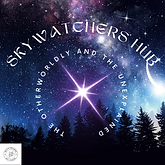Alien Spycraft or Cosmic Coincidence: The Mystery of 3I/ATLAS
- Skywatcher's Hub

- Jul 27
- 4 min read
Updated: Sep 7
👁 Introduction: A New Cosmic Coincidence Puzzle
In July 2025, astronomers confirmed the third-ever interstellar object entering our solar system, dubbed 3I/ATLAS. Detected on July 1 by the ATLAS survey telescope in Chile, this object is igniting hot debate. It is not just its astronomical rarity that captures attention. Harvard astrophysicist Avi Loeb and his collaborators argue it may actually be artificial. They suggest it could be a possibly hostile alien probe. This probe is destined to reach perihelion in late October and come close to Earth in November or early December. (Wikipedia)

🔭 What Is 3I/ATLAS?

Discovery Date: Discovered on July 1, 2025, and confirmed as interstellar within 24 hours (Live Science).
Speed: Travels at approximately 68 km/s (≈150,000 mph) relative to the Sun, making it one of the fastest objects observed in our solar system (Wikipedia).
Size: Estimated size ranges up to 20 km in diameter—much larger than prior visitors ʻOumuamua and Borisov (Medium).
Age: Potentially over 3 billion years old, originating from the thick disk of the Milky Way (Live Science).
🧠 Avi Loeb’s Hypothesis: Alien Technology in Motion?

Loeb and colleagues (Adam Hibberd, Adam Crowl) published a preprint paper advancing the provocative hypothesis that:
Unusual Trajectory Alignment: 3I/ATLAS approaches Venus, Mars, and Jupiter with a probability of <0.005% for a random path (Medium).
Orbital Plane: Its orbital plane is retrograde and nearly aligned with Earth's ecliptic. This is a rare but gravitationally efficient path possibly designed to avoid detection and allow eventual interception (Medium).
Perihelion Passage: During its perihelion passage around October 29, it will pass behind the Sun from Earth's perspective. This is ideal for a reverse Solar Oberth maneuver (a high-thrust braking trajectory) hidden from observers (Medium).
Optimal Intercept: An optimal intercept with Earth would occur in late November to early December 2025—the time it may reappear from behind the Sun (Medium).
They frame this as a testable but speculative scenario. They explore whether 3I/ATLAS might be an engineered object rather than just an interstellar comet (arXiv).
🧾 What Could Signal an Artificial Origin?

Loeb and his team list key anomalies:
Excess Brightness/Size: Base estimates assume reflected light from a dust-enveloped coma. However, if the coma is minimal, the nucleus may be as large as 20 km—extremely rare (Medium, Penn State Sites).
No Detectable Outgassing: Despite a cometary classification, spectroscopy reveals no clear signs of gas emissions—unusual for such an icy interloper (The Watchers).
Non-Gravitational Motion: If subtle deviations in trajectory are observed, it might suggest onboard propulsion or strategic trajectory correction (Medium).
💬 Caution from the Scientific Community

Most experts remain skeptical:
Observations so far align with natural comet dynamics—coma formation, expected reflection patterns, and trajectory irregularities are within normal bounds (Live Science).
Critics, including astrophysicists Samantha Lawler and Chris Lintott, call Loeb’s artificial-probe theory “nonsense on stilts.” They argue it distracts from legitimate natural science (The Sun).
Even Loeb acknowledges the most likely outcome is that 3I/ATLAS is a perfectly ordinary interstellar comet. He warns that his hypothesis could be wrong (Medium).
📅 Key Dates and Events
| Date | Event & Significance |
|---------------------------|--------------------------------------------------------------|
| Late Oct 2025 | Perihelion (~Oct 29) — Hidden behind the Sun for Earth-based observers (Wikipedia) |
| Early Nov to Dec 2025| Potential visibility re-emergence near Earth; hypothesized intercept window (Medium, arXiv, Live Science) |
| Ongoing through 2026 | Astronomical monitoring intensifies—observations of coma, motion, spectrum possible (Live Science, Medium) |


Current estimates show maximum observable brightness around magnitude ~11.5. This makes it unreachable with typical backyard binoculars—though later observations may improve visibility (Wikipedia, Live Science).
🧪 Final Thoughts: Curiosity or Caution?

Avi Loeb has long championed open-minded scrutiny of mysterious interstellar visitors, from ʻOumuamua to 3I/ATLAS. His Galileo Project aims to detect extraterrestrial artifacts or satellites in our near space environment. This project advances a science driven by observable data and peer-reviewed inquiry (Wikipedia).
While the alien craft scenario for 3I/ATLAS remains speculative, it’s a fascinating scientific thought experiment. This situation reminds us how rare interstellar intruders are and how much we still don’t know.
Whether 3I/ATLAS turns out to be a comet or a cosmic messenger—or simply a whip-smart coincidence—the journey we're witnessing is an invitation to look deeper, question more, and prepare for surprises the universe may still hold.

.png)









Comments